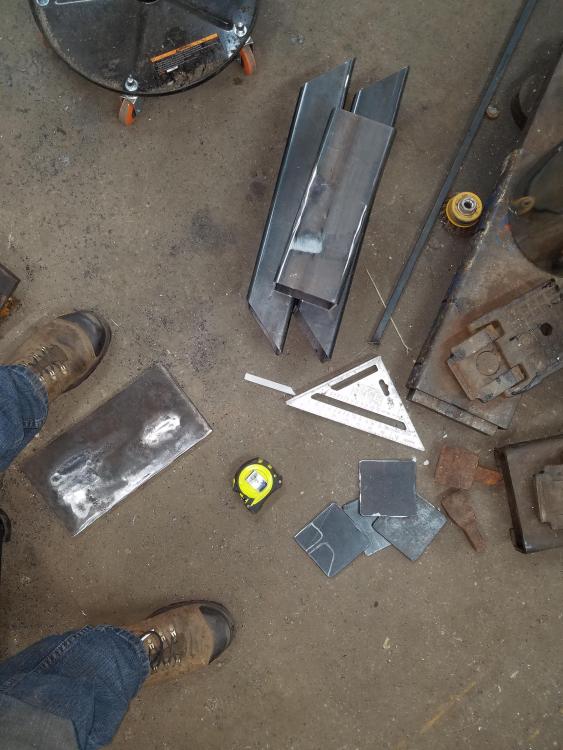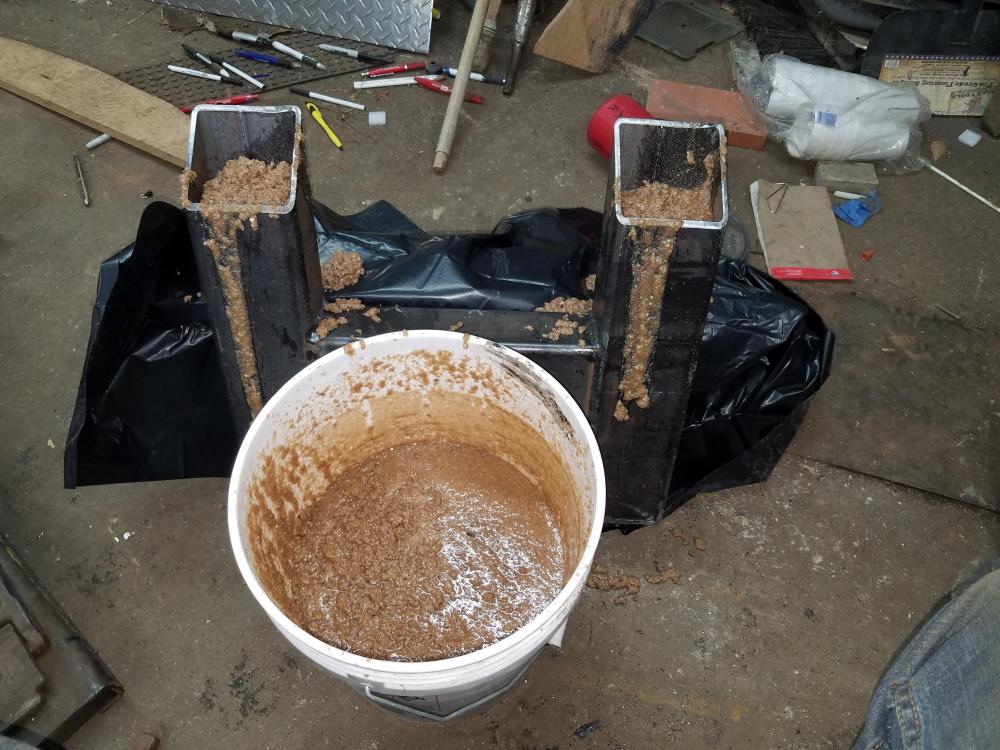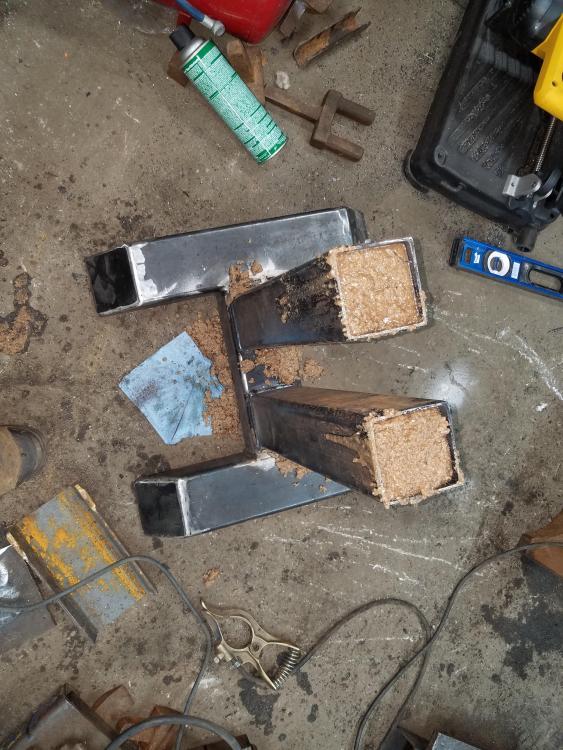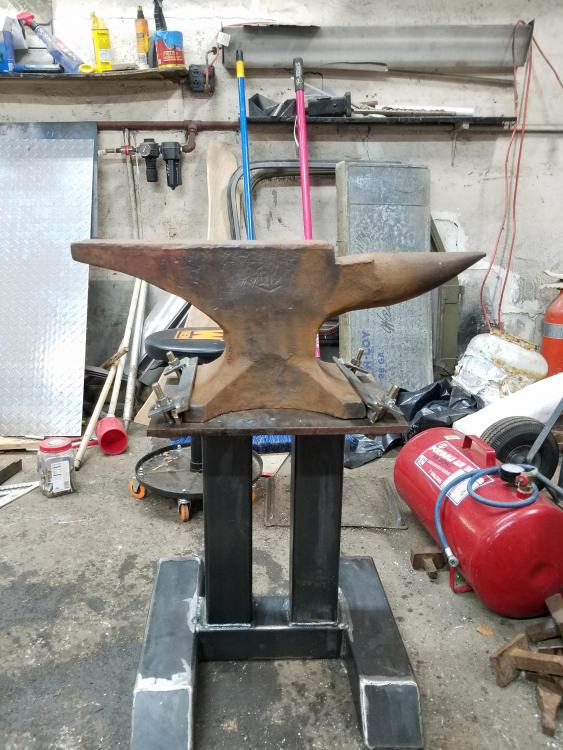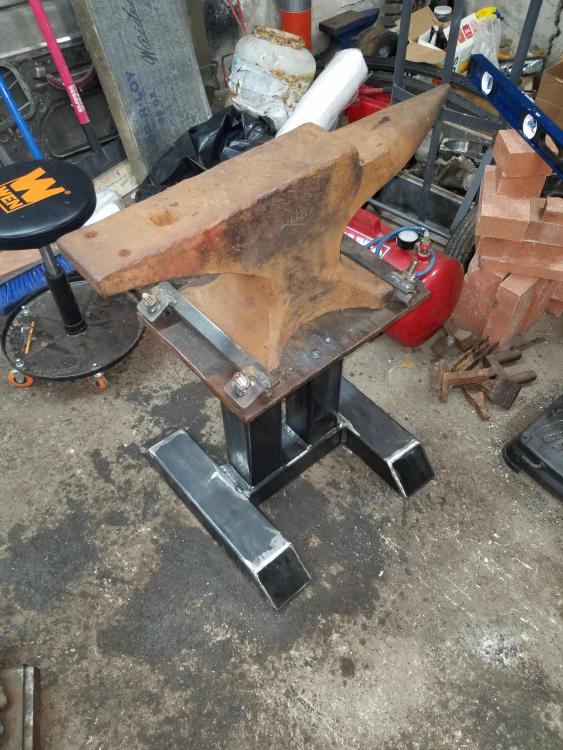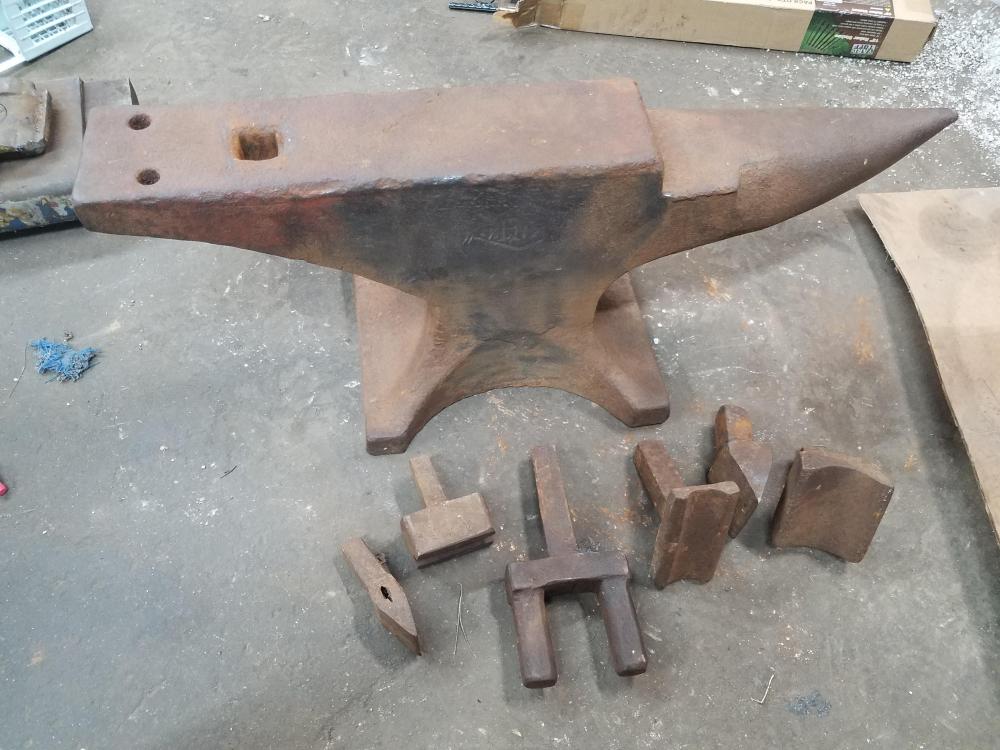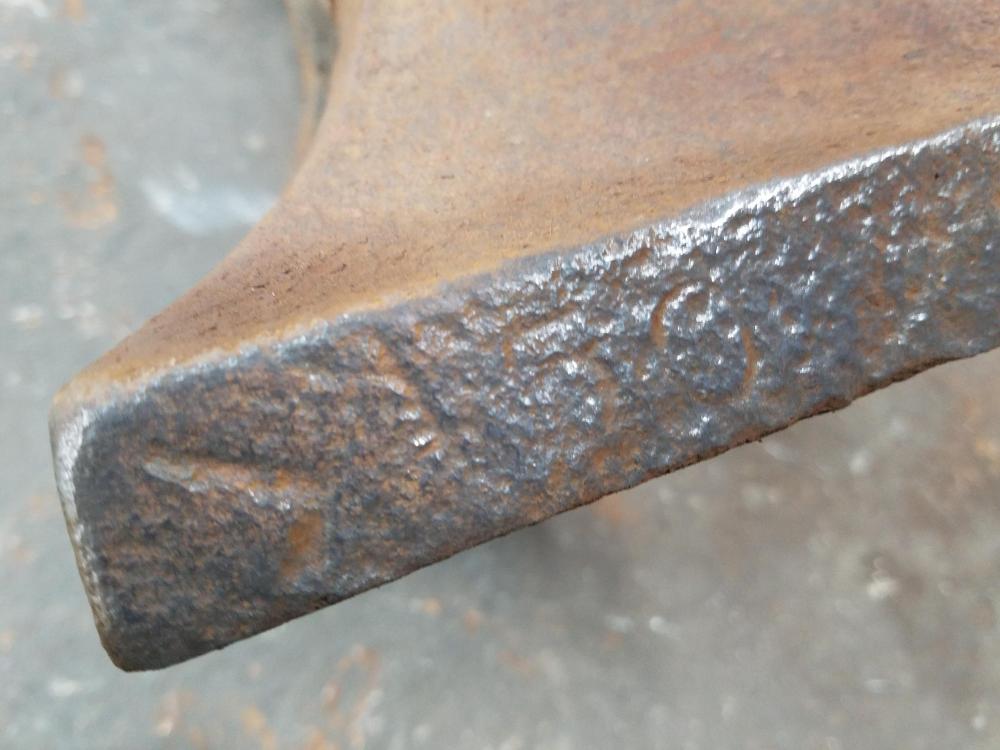
SharpPotato
Members-
Posts
18 -
Joined
-
Last visited
Recent Profile Visitors
The recent visitors block is disabled and is not being shown to other users.
-
Show me your anvil stands
SharpPotato replied to pkrankow's topic in Stands for Anvils, Swage Blocks, etc
It wont flex or twist. If the ends of the tubes were left open, eventually I would deform the top of the bottom center piece, but that is fully welded at each end to the side wall of another 3/16 tube about 1/2 from where those two posts are welded, so that's not gonna happen. With the ends fully welded shut, it makes a big difference in strength, specifically torque resistance. If it were to go out of square at all I would see oil seep from a weld since I ground them smooth. I would be shocked. I could give many real world examples where I have put 1/16"-1/8" walled steel in situations where they needed to last forever and work under much heavier loads. Its how you do it, not the size. This is all 3/16" thick. If I didnt fill it with sand and motor oil it would still be 80-90lbs (guessing). I would say the weakest point is the 3/8 thick top, but since the posts are welded directly under the anvil, the sides are really just acting as something to strap it to. I used 1/2" bolts there, so I can tighten it as that piece moves over time. The way it sits now, if I hit the anvil or my concrete floor with a hammer, they both make the same sound. -
Show me your anvil stands
SharpPotato replied to pkrankow's topic in Stands for Anvils, Swage Blocks, etc
Here is my sound deadening stand I made yesterday since I live in the city. If I want to work after 9, this is a must. Its 4" x 3" x 3/16" base, with two 3.5" x 3/16" posts. The entire thing is filled with a slurry of sand and oil before I welded it all shut. I capped it with a 3/8" plate and used two 1/4" x 1" angle iron pieces with some thick 1/4 washers welded on and 1/2" grade 8 bolts to sinch it down. The base is somewhere around 125lbs-160lbs. I didnt want to break my scale weighing it. Thats a 150# Trenton on top. This anvil rang like a bell. Now it just goes thud. Now onto my gas forge I've been building burners for. That's what the propane tank in the last pic was for, but I decided I will go with that red 7 gallon pressure vessel instead. -
I will create a build if no one beats me to it once I finish. I have found a few different ones, but when I read things like, 'drill a hole in the propane tank to drain it, then you can light the hole if you want and flames will come out', I start to question if other things are the best way to go more than I should. I know that's pretty safe BTW, and from a guy who knows a lot more on this subject than I do, but if you drill a tiny hole like 1/8" it WILL explode like a bomb if you light it. 1/2" hole will just give you a poof. But the best way is to just unscrew the regulator. Ive been planning on setting up a hot work area in my shop for over a year to expand my railing work and stop relying on torches. Now that its time for me to start spending all the money, I am having a really hard time finding all the info I have read in the past. So I google to find it, then I find these threads I have read through that are like books. I knew I was going to hear, read this and that if I created this, but I dont know how many more hours I can devote to finding these needles in haystacks if I want this running before 2019. Anyway, I have two Frosty T Burners built and working. I'm going to go with a ribbon burner, but am curious as to how that will affect the forge if I want to make it smaller a lot of the time to conserve fuel. I may go with a blower on the burner, but I am having a hard time finding actual numbers comparing efficiency and figuring out if they are worth it. Again, I have read many threads, but I would be so happy if I found something like this with a burner comparison. Burner Type: BTUs: Fuel consumption per hr @ _____ PSI Different sizes for same burners etc_____ etc____ I know its a pain to figure out this info, and a lot of it may not be written anywhere, but when I know I am going to use this thing many many hours every week and burn lots of propane, its going to affect my overhead. Thats why I am playing flamethrower into a pile of bricks in my shop and watching how big of a fuel difference were talking about on these. Just trying to figure out whats what exactly. A lot of what I read is guestimation, which I am perfectly comfortable with if I am the one making that guestimation. I am wondering if I should do two small ribbon burners, maybe two NARB burners with a partition to save fuel when I dont have to run pieces all the way through. I know a lot of guys on this site do the same type of stuff already, Im just trying to get there. The build will take no time compared to the research and screwing around Ive already done.
-
I read both, and many other threads from this site and others. I even copy and pasted pertinent info into a word doc to reference. This is a case of, LESS IS MORE. Too much info. Its like if my son asked me what a largemouth VS smallmouth bass look like, so I make him read a book on all species of freshwater fish. There are many solid points made about burners and forges in there when it comes to info people are looking for. The problem is referencing it, indexing it, finding it again. Its like you can go through and read the evolution's of the burners and forge conversations, and why people arrived at the conclusions they did. I have not found a reference for all of the conclusions reached though. Where are all the things people agree on apart from the conversations that got them there? A bullet-point doc or PDF would be nice of probably 50-100 common things people ask across the borard. I see these same questions repeatedly with the same answers "have you read this thread, that thread". Thats why I started copying things into a doc myself. Even then, there is still too much. I cannot imagine trying to navigate all this info if I didnt weld, do masonry, understand thermodynamics, etc. It would be pretty discouraging. Especially on top of all the other things people are trying to figure out.
-
These options are what raised these questions BTW. I was buying things. Looking for the brands I see repeatedly mentioned pulled up a lot of comparable items. Some included with the blankets, some not. Not really the best descriptions when it comes to the details required to make a proper comparison. I take the ratings with a grain of salt. In my experience the manufacturers make sure they get good ratings, some times on sub par products I realized had BS ratings only after I use them. This is the point where my $50-$100 plan is morphing into a $200-$300 plan. No biggie, I just dont want to spend $300, then realize I used the wrong brand trying to save a few bucks and it falls apart after a year. I will buy the products recommended from Wayne Coe's site. I would rather my money go to a smaller business then the empire the screenshot came from. I am just someone who does a lot of research, and doing that on this subject only raised more questions I realized I needed clarification on before spending more money. Edit: Copyrighted catalog list and images removed.
-
Expense is 2 things. One, I asked if it was recommended when casting since that should essentially encapsulate. Two, I dont want to buy a gallon of a product if I need a Quart, just to leave 3 quarts on my shelf. Going on bundles I see being sold of rigidizer and blankets together, I am guesstimating I will need about 2 quarts. If that could be confirmed that would be great. I appreciate you including the active ingredient in rigidizer. I see a lot of brands, and was not sure if there was something about certain brands thats better than others.
-
Awesome. Thats is what I needed to know. I dont want to worry about fibers getting into the air, but also felt like I may be wasting money if I rigidized then cast over it. So I will do both. Do you think 10lbs of KastoLite will be enough? Also, if I take my T-Burner and switch it to a NARB in 3-6 months, when I change the hole and cut back the cast mix and ceramic blanket, is that going to be a nightmare? Am I going to regret big time not going with the NARB from the start, or will enlarging the hole and cutting the shape for NARB not make a huge health hazard style mess? I have a plasma cutter and torches if it makes a difference, but my concern is what will happen when I cut through rigidized ceramic blanket and a couple inches of casting thats been heated and cooled repeatedly.
-
Yeah, I read that. According to him it takes 15lbs, IF you split it in two, which I do not plan on doing. I would assume that requires more casting to make the seam, and less ceramic insulation. He uses KastOLite, but does not mention rigidizer, or a lack of it. He does finish it with IR coating. Some quantities are mentioned in his write up, some are not. So has anyone who put one of these together remember all of their quantities?
-
So I have read through more threads than I can remember here. I emptied and prepped a propane tank yesterday to use for a forge. I removed the regulator, have it all cleaned out, and am ordering insulation parts. Here are my questions I am sure has been answered before. I have a 1" thick Ceramic Blanket rated to 2600F sitting in my shopping cart, plan on doing two layers, but dont want to buy more than I need for other supplies. I plan on casting over the ceramic blanket. I know rigidizer is recommended for the blanket, but should I rigidize the blanket before putting Kast-O-Lite over it? Does it matter? I have never rigidized ceramic blanket before, so I was not sure if it will make the blanket harder before I cast over it and make it last longer, or if it doesnt matter. Also, how much Kast-O-Lite and other materials should I buy for a 20lb Propane Tank Forge? If I need rigidizer (I think I do) is the stuff they sell in quarts on Amazon good enough quality? I know a lot of people here mention the same brand names for certain products. I am trying to figure out how important it is on certain things. For the castable I know it makes a huge difference, but the rigidizer you guys mention most (KAOWOOL) is $100 per gallon. Im not sure how much I need and dont want to buy that much. I am always buying more than I need. I would rather not waste $100-$300 before Christmas on more rigidizer, more castable, and more IR coating then I need. I always seem to have way too much left over when I build stuff, which is usually ok, but all these extras are slowly building up on my property, and all I see when I look at some materials is money sitting on my shelves for things no one will ever buy from me. LOL Thanks for any advice you can offer on buying. I know I am not the only one with unique project supplies I may not use for years accumulating.
-
Yup, I read a lot of that thread. Its been so much info on here.What I really would like are the formulas for calculating everything volume to burner/btu ratio. I have thought about casting a forge too. I have a lot of fireclay, lime, portland cement. If anyone has a good recipe that would be good too. I dont think the ones I know will hold up to a forge. I could cast it with a bung of some type to stick the burner in. I am not sure how much volume to how many BTUs. I want it to get as hot as possible, while being as efficient as is reasonable to have a good burning forge. I already have a large exhaust fan in the roof of my shop, it like 36" 1/3hp. I have carbon monoxide detectors too.
-
I know a lot of threads here are people asking questions already answered, so I will try and keep this simple. I have a bunch of brand new firebricks I used to rebuild my fireplace last year. I have half and full bricks, about 15 of each. I have multiple propane tanks that are full, and lots of thick metal on hand. The bricks I was told are high enough quality to build a kiln. I also have Heat Stop 50 refractory mortar. The brick yard I bought them from said they are high enough quality for any application where they will be exposed directly to very high heat for long periods of time. They were the best firebricks they had. So the questions I have are pretty simple. I want to make a small brick forge that runs on propane so I don't need to put a chimney in my shop, and line the inside with 1/2 bricks so as they get damaged I can slide new ones in. Should I get a different type of half brick to line the inside? I dont want to spend more than required right now. Also, I've been looking at burners. They arent cheap, so I dont want to buy the wrong one. I just want something where I should be good for a few months before I decide if I want to change anything. I read using full brick for the floor will suck the heat out and stop me from getting it super hot. I will spend $100 on a burner now if it means I can use it for my next forge too. I dont want to spend more than needed tough. Just my background. Ive been welding for almost 10 years. I make railings from time to time, and got an anvil to raise my hot work skills to the level they need to be for a guy who live in a historical city. I have used an ASO and oxy/acetylene torches in the past. I just need a forge to heat right now about the last foot of rail at a time. I dont want to burn more fuel than needed, so I would like a single burner to start, and if that is not enough, I figured I could make the forge longer and add another burner. I know this forge in the video probably isnt the best, but I thought the design may benefit me. I was thinking maybe I would make one of these long enough for 2 or 3 burners, but only put in one to start. I figured I would save fuel and figure out how long I actually need it that way. I have made the mistake of using my materials in the past, only to realize when its too late I should have done something a better way. Since I will be tying up at least a couple hundred bucks, I hope whatever I do keeps me happy for a year. The burner on this design made me skeptical it would be worth the time for me to make. I dont know enough though.
-
Asking for help with anvil stand
SharpPotato replied to SharpPotato's topic in Stands for Anvils, Swage Blocks, etc
Thanks for the info! -
Any recommendation in particular on a steel DIY stand? Ive been welding for years and just bought an anvil. Need to make a stand. I have 4x4 3/16 wall tube, 1/8" plate 3/16 plate, 1/4"x4" angle. Too much to list. Havent figured out what I should use yet. Sounds like you have them figured out.
-
uncommon/rare Hay-Budden
SharpPotato replied to RHarrison's topic in Anvils, Swage Blocks, and Mandrels
Thread CPR I have one identical to what you describe. 150# Trenton I just bought. Curious is you could point me towards more information on it. I have no serial, seems gone. All I can see for sure is 150 and the worn out Trenton mark. I think its a Z150, but not 100% on the Z.
